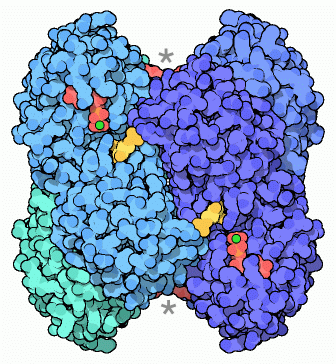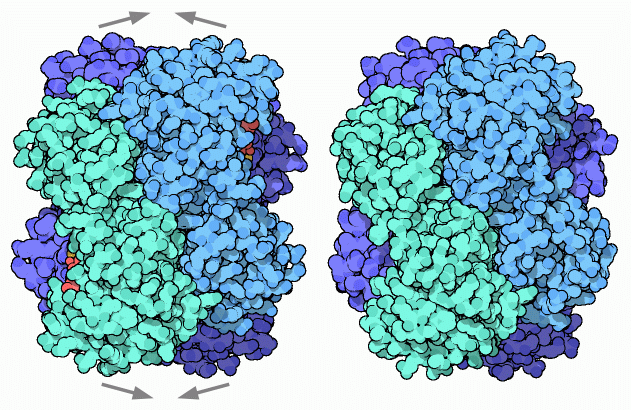|
Inhaltsübersicht | Nanomaschinen | Moleküle | Programme | Kurse | Fun | Links |
||
| > |
The Glycolytic Enzymes


Phosphofructokinase
At the third step of glycolysis, we reach the major point of regulation. Glucose-6-phosphate and fructose-6-phosphate, formed in the first two steps of glycolysis, are used by other cellular processes. But when phosphofructokinase adds a second phosphate to the sugar, it is committed for complete breakdown. Phosphofructokinase is like a miniature molecular computer that senses the levels of different molecules and decides if the time is right for breakdown of sugar. For instance, when ADP and AMP are common, the cell needs to make ATP, so the enzyme turns on. Phosphfructokinase is a mechanical computer, with moving parts. The bacterial enzyme shown at the right (from PDB entry 4pfk) is composed of four identical subunits. The forms in our own cells are even larger and more complex. The active site binds to the sugar, shown in orange, and an ATP, shown in red (this structure actually has ADP bound, along with a magnesium ion shown in green). Notice how each binding site for the sugar is composed of two different subunits, closing around either side of the molecule. The enzyme also has regulatory binding sites at the top and bottom--you can just see the other ADP molecules bound there, marked with asterisks. As shown below (looking from the side of the enzyme) the whole enzyme to shifts when ADP and other molecules bind to the regulatory sites. The active state is shown at left from PDB entry 4pfk, and an inactive structure is shown on the right from PDB entry 6pfk. When the enzyme shifts, the shape of the active site is changed and the enzyme switches on and off.A hint: when you are looking at the structures of phosphofructokinase in the PDB, be sure to download the entire biological unit, which contains four subunits! For a tutorial on biological units, click here.
Next: 4: Fructose 1,6-bisphosphate Aldolase
Previous: 2: Phosphoglucose Isomerase
Last changed by: A.Honegger,